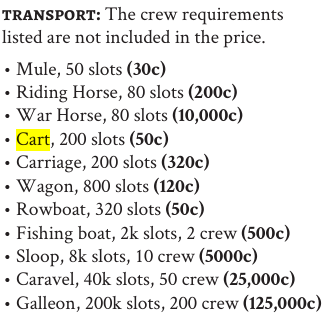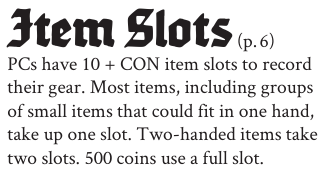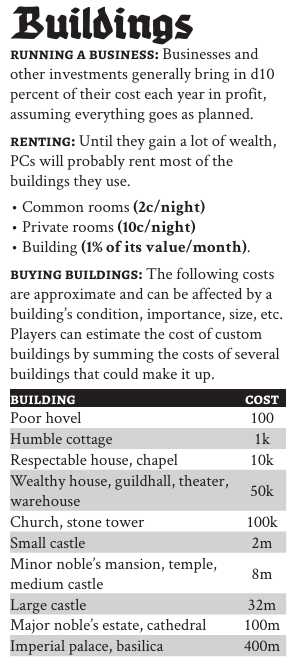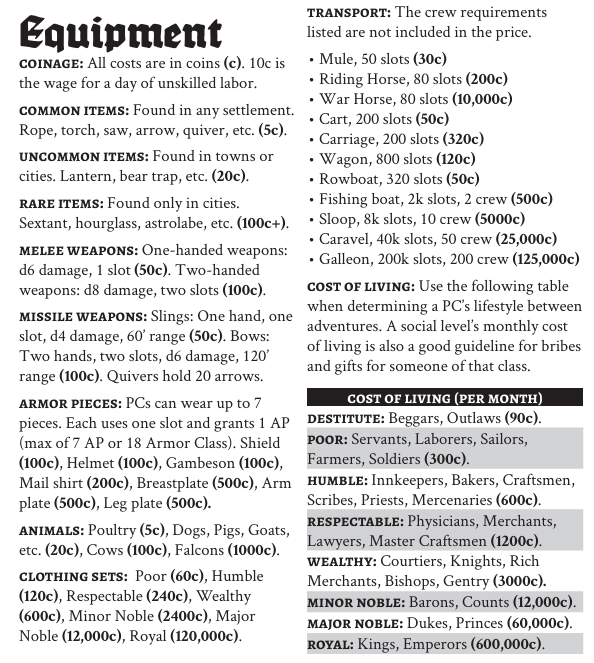I'll be the first to admit that this has been a long time coming. I've mentioned that I've been working on this piece several times and it's high time to finally get this out of my drafts and into the wide world.
Knave, and Knave 2nd Edition, are both fantastic games but as with anything you focus on for a long time, you'll find rough edges and bits that could be improved. I'm at that point with Knave 2e, and I'd like to talk about it.
Moreover, I want to talk about both what Knave 2e does well, and what I think it could do better. I want to talk about some weirdness I've experienced, and speculate on what I think might be a viable path for me to "fix it". Now, I don't say that in a way that you should read as fixing the game for you, dear reader. I mean that I've got a few ideas about how I could maybe fix it for me, and if that resonates with you too, awesome. If it doesn't... well, that's okay too.
I've primarily run Knave (and Knave 2e) as a solo game, so I will focus on my experience as a soloist. This might run differently at a table, but I suspect many of my complaints would transfer directly to group play and possibly become more problematic instead of less problematic.
So, let's get right into it and look at what I think are some of Knave's strengths and weaknesses.
Strengths
In no particular order, and as a likely non-exhaustive list of my observations while playing:
Knave 2e has been built in a way that it caters well to folks who want to play in a predominantly low-magic fantasy setting, which I know a lot of folks really like. Magic exists in the core rules, but the focus is definitely on sword-and-board fantasy more than it is on magic spells. There are (insofar as I'm aware) no out-of-the-box damage spells within the core rules. Magic can be powerful, but rules-as-written, it won't be dealing direct damage. It can control and manipulate and obfuscate, but to get something like a Fireball out of this system you need to create it or import it.
The system is Classless. You don't choose to be a Fighter or Paladin or Wizard and are then stuck with that playstyle. You are what you carry. You can fit any role you want, simply by having your chosen gear reflect that. If you want to be a Knight, you slap on a helmet, grab a shield, a sword, and a horse. If you want to be a wizard, you snag a handful of spellbooks. If you want to be a rogue, you bring along some lockpicks and easily concealed weapons. What role you play is up to you, and unlike class-based systems, you're free to change your playstyle as you go. A caveat here is that whatever you've dumped your points into for ability scores will make you better/worse at some roles. It doesn't mean you can't still achieve success, it just makes your dice rolls more interesting.
The rules are absolutely chock full of amazing tables. For folks running games and designing encounters, this is an absolutely invaluable tool in your DMs toolkit.
The game runs extremely well at low levels and brings with it a sense of danger and a weight to your choices that a lot of OSR D&D clones don't capture as well.
There are a lot of suggested ideas for what you could, potentially, do in a longer-running campaign. Things like owning buildings, or participating in warfare. These are supported by rules and tables that you can reference when or if you get to that point.
The game's currency is simplified. Whereas we have gold, silver, copper, electrum, platinum, etc in other systems... Knave simply uses "coin". There is no conversion to be done, you simply have a standardized and somewhat abstracted pool for your currency. Whether you choose to think of the coins as gold, silver, or copper in the fiction, it doesn't make any difference mechanically.
The rules are set up in such a way that you are encouraged to recruit hirelings, which I think is just a really neat thing to have. I'm always pleased when hirelings/retainers are supported by the core rules of a game system.
This book has so many great tables to roll on for a huge variety of things. Backgrounds, items, magic, so many things that you could use as a GM or soloist. The tables are an amazingly rich feature that can be used without any other part of this ruleset.
There is an alchemy system built into the game, and while we don't have a lot of guidance on how harvesting plants and animals to create potions should work, it does plant the seed of going all 'Monster Hunter' and collecting parts. Which is great until you remember that everything you harvest requires a slot.
Weaknesses
The slot system and wound system.
I think I understand what the goal was in the design: make it impossible to just chuck everything into a never-ending black hole of lugged-around equipment. And, at low levels this mostly works. Inventory management isn't exactly something I love, but there are those who do, and maybe they would like this. With that said though, it only really functions well at lower levels. As soon as you've got enough money to buy a Cart (50c for 200 slots) and Mule (30c for 50 slots), it breaks down. Nobody - and I mean nobody is going to meticulously keep track of 200 items sitting in their cart. It instantly becomes an abstraction - and with a party of 4 players, you can afford this at the very start of the game. This means at the most, you're one long walk through a dungeon back to your cart away from all the items that the slot-based system was meant to keep you from lugging around.

Even a riding horse is 80 slots, and I don't care how much a person might claim to love inventory management, I straight up refuse to believe that anyone is out there keeping track of their 80 slots, particularly when it's not always 1-to-1.
Item Slots (p. 6)
PCs have 10 + CON item slots to record their gear. Most items, including groups of small items that could fit in one hand, take up one slot. Two-handed items take two slots. 500 coins use a full slot.

Another point to tack onto this is that wounds start with your top left item slot, and whatever is in that drops. So, on top of managing your already small available inventory, you've also got to think about "what do I care least to keep" and place your items in your available slots accordingly, so that useful gear like, say, your shield or weapon, is last to drop.
I think this was meant to make combat feel more dangerous, and like you were trading dropping loot for surviving another day. And, again... maybe there are folks out there who find this kind of playstyle super fun. I'm not one of them.
The whole slot system feels like a concept that would be unbelievably cool in a Knave-based videogame, but that at the table where we're actually playing the game... just adds needless micro-management. I don't want to have to roleplay, or god forbid, GM a scene where my players/characters are just popping in and out of the dungeon hauling out one box of treasure at a time and loading it onto a mule because slots exist and must be used. It's not fun, and it's not interesting. The most interesting thing you could do is split the party and force a combat encounter - and how many times are you going to do that before you decide to just handwave it away and state that it takes an hour or two to gather the dungeon's loot and then you move on. Which is what we'd do if slots didn't exist too, unless you could reasonably carry the bits and bobs you pick up.
Dungeon Hazards and Travel Hazards.
I will say, I overall enjoy this mechanic, but where I take issue with it is in the frequency of rolls. Delve Shifts are every Turn (10 min) while in a dungeon, and Travel Hazards are at the end of each Watch (four-hour chunks of day representing 3 for day, 3 for night). These both have options which can spawn additional rolls, and could also spawn combat encounters.
While dungeon delving, time is tracked in 10-minute segments called turns. Most actions (moving, searching, fighting, resting, etc.) take up one turn.
Now, you could absolutely ignore this mechanic entirely and it would be fine. Or you could do as I usually do, and cut the frequency substantially, but using it Rules-As-Written, you've got a real chance at grinding the actual play to a halt while you deal with various setbacks and spin-off events and rolls. There are others who actually crunched these numbers, like Beau Rancourt's Knave 2e Analysis where he found that a simple 6 hex travel resulted in a whopping 127 rolls using Rules-As-Written. That's insane, and with the few hexes I travelled over myself as a solo player before abandoning RAW and scaling back the checks, that definitely fits what I've observed. As written, this is cumbersome and while I'm sure some folks might really enjoy it, I am not among that number.
Both Travel Hazards and Dungeon Hazards have the ability to deplete your resources (Rations in Travel, and Torches in Dungeons), and both have the ability to spawn combats. You can get lost. You can have the dungeon dramatically change due to Delve Shifts. A lot of these require you as a DM to be pretty fluid about thinking on your feet as to how you tie these non-attrition-based effects into your session if you're running any kind of a story. They work fairly well if you've planned nothing and there is no thread of narrative to weave through events, however. If you're just crawling a dungeon to crawl through a dungeon, I suspect these would work fine. I rarely do that in this game though... after all, I have 4 Against Darkness, 2d6 Dungeon, and other fine games like them to provide purely randomized dungeon-crawling fun.
Combat can be slow.
Knave 2e doesn't have a strength-based bonus to attack values. What you roll for your damage die is what you get, and that means you're limited to a d4, d6, or d8 worth of damage no matter your level. A level 1 Knave is for all intents and purposes, just as strong as a level 5 Knave. The level 5 character will hit more often, statistically speaking (because Str does affect that), but it won't do any extra damage. Again, as I've said so often in this section, I believe this was designed that way to disincentivize straight-up combat. We are encouraged to think about how to fight dirty and tip the balance of an encounter in our favour, and I believe this was purpose-built to attempt to force that playstyle.
Subpoint: The Bestiary is extremely small. We get a handful of pre-generated creature stats, and they are a great starting point but the way they've been ported from AD&D/BX/Etc leaves some creatures even more dangerous than they'd normally be. Black Pudding has 40hp, 13AC, and can only be damaged by fire. It dissolves metal and wood, and can move across walls.
So, taking what we know about combat, that means you'd have to have some way to coat your weapon in fire and you'd still be at most taking 1d8 out of it per player per turn, assuming you hit. It is a level 10 creature, so is considered an end-game style of monster, but it is absolutely brutal nonetheless.
The Economy and Owning Buildings
Oh boy, what do I say about this part? There's a whole economy section that I should really write out but to sum it up: the entire economy of the game really requires you to not pay attention to the numbers and think about them critically. Like, at all. This affects everything from purchasing equipment, to levelling up (because our level is tied to how many coins worth of items we have recovered).
To get to level 2, for example, we need to recover 2000 coin-worth of treasure. To get to level 10, we need to have plundered 500,000c worth of treasure. Which must be carried out in your available slots, which are also necessary for the armor and weapons you're holding. But I digress.
You "can" buy, rent, or build various buildings in Knave. At least, on paper you can do that. In reality, half of the list is entirely outside of your ability to ever earn enough gold to purchase unless your DM is very permissive and provides a whole ton of time-skips where you still come back with a ton of money. Most of the list you'll never realistically be able to rent, and you'll darn sure never buy or build.

Beyond owning buildings, you could recruit hirelings/mercenaries, train in new careers, or gamble and carouse. Of course, you're also spending on any equipment and items you need to adventure with, and spending on your default Cost of Living per month.
Cost of Living (Per Month):
destitute: Beggars, Outlaws (90c).
poor: Servants, Laborers, Sailors, Farmers, Soldiers (300c).
humble: Innkeepers, Bakers, Craftsmen, Scribes, Priests, Mercenaries (600c).
respectable: Physicians, Merchants, Lawyers, Master Craftsmen (1200c).
wealthy: Courtiers, Knights, Rich Merchants, Bishops, Gentry (3000c).
minor noble: Barons, Counts (12,000c).
major noble: Dukes, Princes (60,000c).
royal: Kings, Emperors (600,000c).
This gives you a basic idea of how much you (and folks in the wider world) spend during a month of downtime. It doesn't give us any indication of what they earn, but what they spend is still useful.
For hirelings we can spend 300c per month to get torch-bearers and porters that will follow us into dungeons but will also run away at first sign of danger. We can spend 600c for a Mercenary that will fight for us but won't come into dungeons with us. Finally, we can spend 600 to 2400c per month for an "expert" recruit.
Common experts (carpenters, hunters, blacksmiths, etc.) are found in any settlement, uncommon experts (acrobats, brewers, locksmiths, etc.) are only found in towns and cities, and rare experts (alchemists, magicians, assassins, etc.) are only found in cities.
You can also get a 'Companion' that is built more like a player character, but each player can only get a limited number of these ever.
A PC’s CHA sets the maximum number of companions that will ever follow the PC over the course of their life.
And finally, let's look at the cost of various pieces of Equipment:
common items: Found in any settlement. Rope, torch, saw, arrow, quiver, etc. (5c).
uncommon items: Found in towns or cities. Lantern, bear trap, etc. (20c).

Why is a single arrow the same price as a quiver? Is that a typo?
Why is a lantern only barely less expensive than a mule?
Why is a set of humble clothing going to cost you 120c? A single set! If we assume Humble clothing matches the Humble cost of living career types, does that mean that a baker spends 20% of their monthly expenditure on a set of clothes?
The more you think about the cost of items, the less it makes any sense and the more it feels like it was decided completely arbitrarily. Which is fine, I get that folks probably don't often think about how their fantasy dungeon game's economy works but it just annoys me and while the simplicity of using a single type of currency is supposed to make me think less about how the world works, it does just as bad of a job as D&D does. I recognize that my gripes about prices not making sense might be a me issue, but damn it this blog post is about my issues with the game, so I'm keeping it in here.
I'm going to tack onto this that everywhere that we see career types being 'common, uncommon, rare' etc... there's nowhere that provides any guidance on how to rule that. We have a d100 table of career types which is awesome but there's zero guidance on what to rule as being common, uncommon, or rare except your gut feeling about the career itself.
I think Ben hates magic.
The whole magic system feels like a big middle-finger to anyone who likes playing magic casters. If you want to cast a spell, you need to have a book for it. A single book can only hold one spell, which can only be used once per day, and you can only use a number of spellbooks equal to your INT, which is then also limited by how many slots you have which is in turn limited by how many points you dumped into CON. Added to this limitation, there are no damaging spells in Knave by default. Everything spell-related is for control, concealment, manipulation, or other non-damaging effects. The ability to be a fireball-casting wizard is something that was purposely not supported in Knave.
It's okay to not like magic, and it's okay to not like damaging magic in particular... but to so severely hamper a caster type is a wild choice to me. I think the magic provided IS interesting, but the requirement of a single book per spell per day makes it too detrimental to bother with. Why would I fill one of my ~10 slots with a spellbook that might be useful once per day? That's crazy.
Closing Thoughts
Knave 2e has a lot of promise. It's got a lot of cool stuff going for it. And while I spent a long time talking about the stuff I don't like, it's not because I don't like the game. If I didn't love Knave, I would shrug and just move on to something else. But I do enjoy it. It's a great little game, and one I fully intend to keep playing - but I'm going to definitely spend some time taking a rock to the rules and bashing the edges I don't like off. I have some ideas on how to rework slots so that we're not speed-running the point where we can abstract them. I want to toy with the wound system to make it more interesting. I have... all kinds of little ideas on how I might be able to take this as a starting point and coax it into a game I like even more.
Now, I'm no game designer, and I suspect it's going to be a ham-fisted attempt to get it working in a way that is more fun for me... but I have to try because if I don't at least attempt to smooth what I see as weaknesses, it'll pick at me in the back of my head and I'll keep turning these thoughts over and over wondering if they'd work. And doing that would drive me crazy.
So, this won't be the last you hear about Knave. It probably won't be the last of my complaints OR my ravings about how cool parts of it are. And, with any luck, I'll eventually return with something I tried to cobble together off of this as a stepping-stone. We'll see.
Until then, for the like, two of you who'll make it through this winding ramble of a post... thank you, and as always: Happy Gaming.
This is a good analysis ! I think the reality is that most games are just that, and expecting the economics to make any sense at all is a pipe dream.
Unless you're playing Chivalry and Sorcery. Oh god... the most complex RPG ever designed. 100+ pages of close packed small print tables that enable you to simulate 12th century France in minute detail. Beautiful as a reference source, hard to play.
I'd love to see some of the mechanics you put together to make Knave work ! Perhaps what needs to be added is "day job" earnings, so that as you climb the ranks of nobility you accumulate peasants (or parishioners for priests...), and earn a tithe from each one to help keep up your shiny new castle or church 😀 Then the adventuring is just a bit of beer money on top.
Yeah I honestly don't know if I'll do much for the economy beyond reducing the cost of a few things (arrows most notably) when/if I come across them and they feel wrong.
As long as I am creating and running my own dungeons I can keep things mostly consistent, it's when you start pulling in other OSR modules that things break down when you realize a single Knight in Knave's default economy burns through the entire hoard of gold you almost died for (imported from another OSR module) in just a few months. Why go adventuring at all? If a Knight - not even a noble - is making that much, why is anyone risking fighting monsters instead of signing up for the military?
Its stuff like that, that I have to just actively ignore and work around.
I'll likely spend a lot longer on making the slot system interesting, since it really bugs me. It doesn't do the job I assume it was designed to do, so I'd like to have it do something else entirely. I want to try my plan before I talk too much about it, but I want to have slots matter still without being necessarily tied to literally everything you ever pick up, because that's just annoying.
I'll definitely talk about it more as I go though. I had been complaining about it to my wife and she just nodded along and then like ten min later went: "so when are you making your game?"
Smartass knows me too well 😂